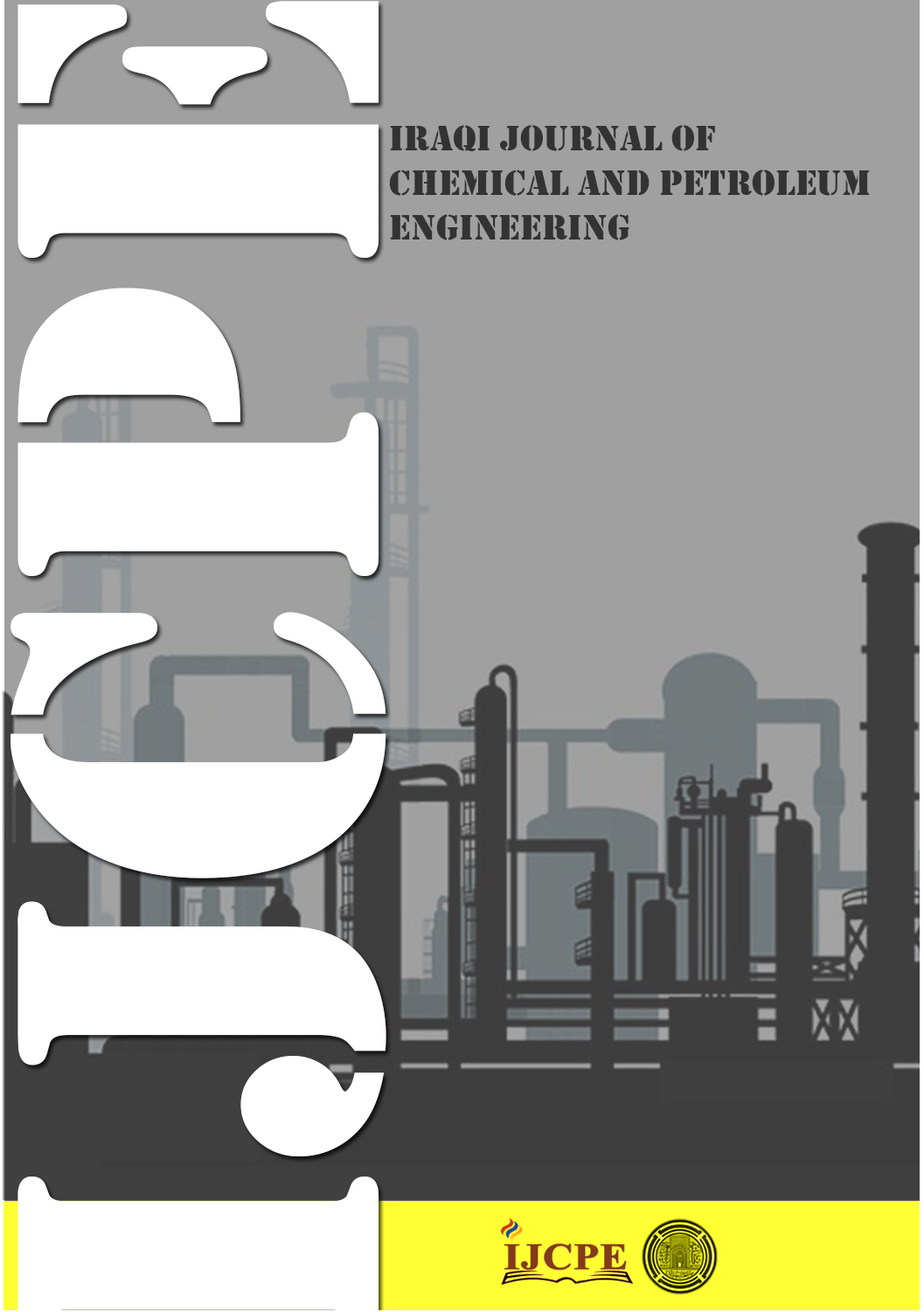A low-cost in-line ozone gas monitor via ultraviolet absorption spectroscopy
DOI:
https://doi.org/10.31699/IJCPE.2025.3.2Keywords:
ozone monitor; UV-absorption; Beer-Lambert lawAbstract
A low-cost in-line ozone monitor based on the principle of ultraviolet absorption was built and tested for different ozone for concentrations up to 300 mg h-1 and flow rates up to 5 lpm using air as a feed source. A widely available T5 ultraviolet (UV) tube was used as a UV source and two UV light absorption cells were made to act as reference and measuring cells. The output of the two cells was used to calculate the ozone concentration using Beer-Lambert’s law. To correlate the output readings of the ozone monitor with those obtained using the iodometric titration method, a correction factor of 1.5117 was determined and applied. The results demonstrate a strong linear correlation ≥0.99 between estimated and measured ozone concentration values. Relative errors less than 10% were observed for ozone concentrations ranging from 400 to 5000 ppb, while a relative error up to 16% was reported for concentrations below 400 ppb. The developed monitor offers a cost-effective alternative to expensive ozone monitoring systems for standard applications, with a total construction cost under $100.
Received on 06/05/2025
Received in Revised Form on 15/07/2025
Accepted on 22/07/2025
Published on 30/09/2025
References
[1] E. I. Epelle et al., ‘Ozone application in different industries: A review of recent developments’, Feb. 15, 2023, Chemical Engineering Journal. https://doi.org/10.1016/j.cej.2022.140188
[2] J. Derco, B. Urminská, and M. Vrabeľ, ‘Introductory Chapter: Ozone in the Nature and Practice’, in Ozone in Nature and Practice, InTech, 2018. https://doi.org/10.5772/intechopen.78263
[3] L. L. Pan et al., ‘Thunderstorms enhance tropospheric ozone by wrapping and shedding stratospheric air’, Geophysical Research Letters, vol. 41, no. 22, pp. 7785–7790, Nov. 2014, https://doi.org/10.1002/2014GL061921
[4] H. Claus, ‘Ozone Generation by Ultraviolet Lamps†’, May 01, 2021, Blackwell Publishing Inc. https://doi.org/10.1111/php.13391
[5] M. F. Link, A. Shore, B. H. Hamadani, and D. Poppendieck, ‘Ozone Generation from a Germicidal Ultraviolet Lamp with Peak Emission at 222 nm’, Environmental Science and Technology Letters, vol. 10, no. 8, pp. 675–679, Aug. 2023, https://doi.org/10.1021/acs.estlett.3c00318
[6] E. S. M. Mouele et al., ‘A critical review on ozone and co-species, generation and reaction mechanisms in plasma induced by dielectric barrier discharge technologies for wastewater remediation’, Oct. 01, 2021, Journal of Environmental Chemical Engineering. https://doi.org/10.1016/j.jece.2021.105758
[7] V. Gibalov and G. Pietsch, ‘On the performance of ozone generators working with dielectric barrier discharges’, Ozone Science and Engineering, vol. 28, no. 2, pp. 119–124, May 2006, https://doi.org/10.1080/01919510600559419
[8] M. Rodríguez-Peña, J. A. Barrios Pérez, J. Llanos, C. Sáez, M. A. Rodrigo, and C. E. Barrera-Díaz, ‘New insights about the electrochemical production of ozone’, Jun. 01, 2021, Current opinion in Electrochemistry. https://doi.org/10.1016/j.coelec.2021.100697
[9] L. C. Cuong, N. H. Nghi, T. V. Dieu, D. T. Y. Oanh, and D. D. Vuong, ‘Influence of oxygen concentration, feed gas flow rate and air humidity on the output of ozone produced by corona discharge’, Vietnam Journal of Chemistry, vol. 57, no. 5, pp. 604–608, Oct. 2019, https://doi.org/10.1002/vjch.201900095
[10] J. D. McClurkin, D. E. Maier, and K. E. Ileleji, ‘Half-life time of ozone as a function of air movement and conditions in a sealed container’, Journal of Stored Products Research, vol. 55, pp. 41–47, Oct. 2013, https://doi.org/10.1016/j.jspr.2013.07.006
[11] K. Varol, ‘Determination of maximum ozone concentrations and half-life of ozone in some drinking water and high-quality pure water produced in new system devices’, Fresenius Environmental Bullten, vol. 31, no. 2, pp. 2285–2294, 2022.
[12] A. N. Al-Baarri, A. M. Legowo, S. B. M. Abduh, A. A. Mawarid, K. M. Farizha, and M. Silvia, ‘Production of ozone and the simple detection using potassium iodide titration method’, in IOP Conference Series: Earth and Environmental Science, Institute of Physics Publishing, 2019. https://doi.org/10.1088/1755-1315/292/1/012062
[13] U. Chasanah et al., ‘Evaluation of Titration Method on Determination of Ozone Concentration produced by Dielectric Barrier Discharge Plasma (DBDP) Technology’, in Journal of Physics: Conference Series, Institute of Physics Publishing, Feb. 2019. https://doi.org/10.1088/1742-6596/1153/1/012086
[14] J. Baranwal, B. Barse, G. Gatto, G. Broncova, and A. Kumar, ‘Electrochemical Sensors and Their Applications: A Review’, Sep. 01, 2022, Multidisciplinary Digital Publishing Institute (MDPI). https://doi.org/10.3390/chemosensors10090363
[15] X. Pang, M. D. Shaw, A. C. Lewis, L. J. Carpenter, and T. Batchellier, ‘Electrochemical ozone sensors: A miniaturised alternative for ozone measurements in laboratory experiments and air-quality monitoring’, Sens Actuators B Chem, vol. 240, pp. 829–837, Mar. 2017, https://doi.org/10.1016/j.snb.2016.09.020
[16] A. Ripoll et al., ‘Testing the performance of sensors for ozone pollution monitoring in a citizen science approach’, Science of the Total Environment, vol. 651, pp. 1166–1179, Feb. 2019, https://doi.org/10.1016/j.scitotenv.2018.09.257
[17] L. Petani et al., ‘Development of an Experimental Setup for Real-Time In-Line Dissolved Ozone Measurement for Medical Therapy’, Ozone Science and Engineering, vol. 44, no. 5, pp. 499–509, 2022, https://doi.org/10.1080/01919512.2021.1932412
[18] M. David, M. H. Ibrahim, S. M. Idrus, and T. C. E. Marcus, ‘Fundamental review to ozone gas sensing using optical fibre sensors’, Telkomnika (Telecommunication Computing Electronics and Control), vol. 13, no. 4, pp. 1133–1144, 2015, https://doi.org/10.12928/TELKOMNIKA.v13i4.2047
[19] I. V. Nikolaev, V. N. Ochkin, F. Y. Khadzhiiskii, S. N. Tskhai, and V. F. Chirkin, ‘Atmospheric ozone concentration measurement by UV light-emitting diode radiation absorption’, Bulletin of the Lebedev Physics Institute, vol. 40, no. 2, pp. 50–53, 2013, https://doi.org/10.3103/S106833561302005X
[20] S. O’keeffe, C. Fitzpatrick, and E. Lewis, ‘Ozone measurement using an optical fibre sensor in the visible region’, IEEE Xplore, 2005, https://doi.org/10.1109/icsens.2005.1597810
[21] S. Jodpimai, S. Boonduang, and P. Limsuwan, ‘Inline ozone concentration measurement by a visible absorption method at wavelength 605 nm’, Sensors and Actuators B Chemical, vol. 222, pp. 8–14, 2016, https://doi.org/10.1016/j.snb.2015.08.028
[22] V. Gorshelev, A. Serdyuchenko, M. Weber, W. Chehade, and J. P. Burrows, ‘High spectral resolution ozone absorption cross-sections – Part 1: Measurements, data analysis and comparison with previous measurements around 293 K’, Atmospheric Measurement Techniques, vol. 7, no. 2, pp. 609–624, Feb. 2014, https://doi.org/10.5194/amt-7-609-2014
[23] J. Orphal et al., ‘Absorption cross-sections of ozone in the ultraviolet and visible spectral regions: Status report 2015’, Journal Molecular Spectroscopy, vol. 327, pp. 105–121, Sep. 2016, https://doi.org/10.1016/j.jms.2016.07.007
[24] B. Al-Sabbagh and N. N. Abdulrazzaq, ‘Measuring Dyes Concentration Using a Low-Cost Visible-Light Spectrophotometer’, Iraqi Journal of Chemical and Petroleum Engineering, vol. 23, no. 2, pp. 27–33, Jun. 2022, https://doi.org/10.31699/ijcpe.2022.2.4
[25] A. Y. Tolbin, V. E. Pushkarev, L. G. Tomilova, and N. S. Zefirov, ‘Threshold concentration in the nonlinear absorbance law’, Physical Chemistry Chemical Physics, vol. 19, no. 20, pp. 12953–12958, 2017, https://doi.org/10.1039/c7cp01514c
[26] M. K. Kiteto and C. A. Mecha, ‘Insight into the Bouguer-Beer-Lambert Law: A review’, Sustainable Chemical Engineering, vol. 5, no. 2, pp. 567–587, 2024, https://doi.org/10.37256/sce.5220245325
[27] C. Gottschalk, J. A. Libra, and A. Saupe, Ozonation of water and waste water: A practical guide to understanding ozone and its application. 2008. https://doi.org/10.1002/9783527613342
Downloads
Published
Issue
Section
License
Copyright (c) 2025 The Author(s). Published by College of Engineering, University of Baghdad.

This work is licensed under a Creative Commons Attribution 4.0 International License.













